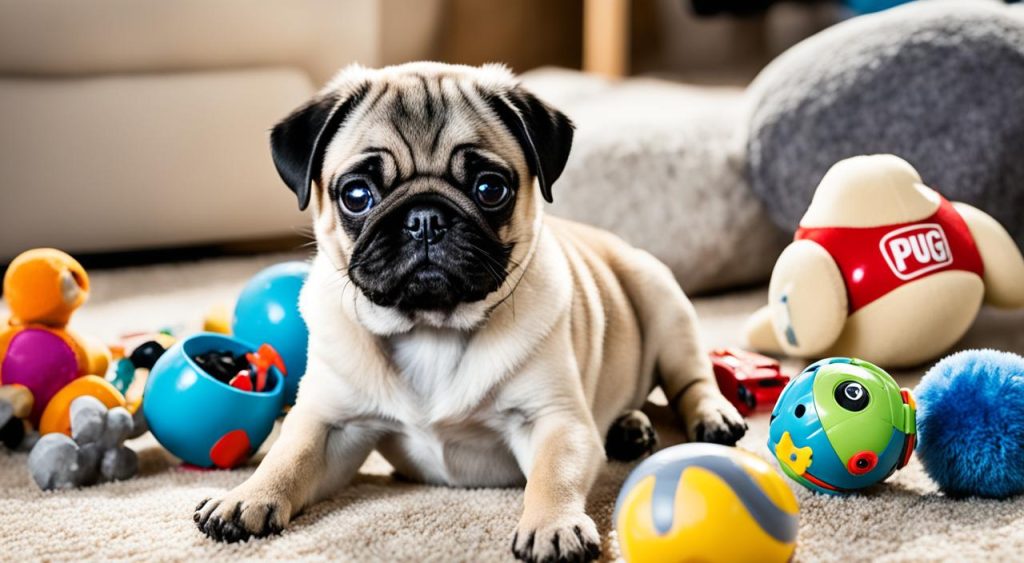When considering adding a Pug to your family, one of the first decisions you may encounter is whether to choose a male or female Pug. While both genders have their own unique characteristics, traits, and behaviors, there are no definitive answers as to which is better. It’s important to take into account various factors such as their physical differences, temperament, trainability, health considerations, and your personal preferences. Here, we will explore the differences between male and female Pugs to help you make an informed decision.
Key Takeaways:
- Male and female Pugs have slightly different physical appearances, with males being slightly larger in size.
- Personality and behavior can vary between male and female Pugs, with males often being more laidback and affectionate, and females being more charming and sassy.
- Both male and female Pugs can be prone to health issues, but males may be more susceptible to bone and joint disorders.
- Consider breeding and heat cycles when deciding between a male or female Pug, as each has its own considerations and responsibilities.
- Ultimately, the decision should be based on your personal preferences, lifestyle, and ability to provide the necessary care and training for your chosen Pug.
Physical Differences between Male and Female Pugs
The physical appearance of male and female Pugs is similar but not identical. Male Pugs tend to be slightly larger, measuring around 10 to 14 inches in height and weighing between 20 to 30 pounds. Female Pugs, on the other hand, are slightly smaller, measuring about 10 to 12 inches in height and weighing between 18 to 28 pounds.
However, there can be variations within each gender, and some females may be as bulky and stocky as males.
Personality and Behavior Differences
When it comes to the personality and behavior of male and female Pugs, it’s important to consider that every dog is unique. However, there are some general differences that can be observed between the two genders.
Male Pugs are often described as laidback and affectionate companions. They love to cuddle and be around their owners. However, they can also be a bit more stubborn and have a shorter attention span, which can make training them slightly more challenging. Patience and consistency are key when it comes to training a male Pug.
On the other hand, female Pugs are often characterized as charming and sassy. They tend to be more independent and self-assured. While they can be equally affectionate, they may also display more aggression and territorial behaviors. It’s important to provide them with proper training and socialization to ensure they grow up to be well-behaved and friendly dogs.
However, it’s crucial to note that regardless of gender, individual training and socialization play a significant role in shaping a Pug’s behavior and temperament. Proper training, positive reinforcement, and consistent boundaries will help both male and female Pugs become well-rounded members of the family.
Health Considerations
When considering the health of your Pug, it’s important to understand that both male and female Pugs are susceptible to certain health issues. These can include skin allergies, breathing problems, hip deformities, and infections. However, there are some differences to be aware of.
Due to their larger body mass, male Pugs are more likely to develop bone and joint disorders compared to their female counterparts.
On average, male and female Pugs have similar lifespans, typically living between 12 to 15 years. It’s worth noting that each Pug is unique, and factors such as genetics, diet, exercise, and overall care can influence their longevity.
When it comes to addressing behavioral concerns, neutering male Pugs can help reduce aggressiveness and marking behaviors, which can be beneficial for their overall well-being. Additionally, spaying female Pugs can prevent complications during pregnancy and reduce the risk of certain health issues.
Considerations for Breeding and Heat Cycles
When it comes to breeding a male Pug, the process is relatively straightforward. All you need is a female Pug in heat to introduce to the male. However, it’s crucial to supervise the breeding process to ensure the safety and well-being of both dogs involved.
Female Pugs go through heat cycles, which typically occur 2-3 times per year. During this time, they may exhibit mood swings, aggression, and may experience discharge. It’s essential to be prepared for these changes and provide the necessary care and attention.
“Male Pugs may become more aggressive and display territorial behaviors, such as marking and attempting to escape in search of a female in heat.”
Understanding your male Pug’s behavior during heat cycles is also important. They may become more assertive and demonstrate territorial behaviors. This can include marking their territory and attempting to escape in search of a female in heat. It’s crucial to provide proper supervision and take appropriate measures to prevent any unwanted or unsafe situations.
Considering these factors, it’s essential to make an informed decision about whether you want to breed your Pug or opt for spaying/neutering. Breeding should only be pursued with a thorough understanding of the process and a commitment to responsible breeding practices. Spaying or neutering your Pug can help manage their behavior and prevent any potential health complications.
Conclusion
Deciding whether to get a male or female Pug is a personal decision that depends on your preferences and lifestyle. While there are some differences between the two genders, it’s important to remember that individual personality, training, and socialization have a significant impact on a Pug’s behavior and temperament.
Consider the physical differences between male and female Pugs, such as their size and weight, as well as their trainability. Both genders can make loving and affectionate companions, but male Pugs may be slightly more laidback and stubborn while female Pugs can be charming and sassy but also more aggressive and territorial.
Health considerations should also be taken into account. Both male and female Pugs can be prone to certain health issues, but males may have a higher risk of developing bone and joint disorders due to their larger body mass. Neutering males and spaying females can help prevent certain health issues and behavior problems.
Ultimately, the decision between a male or female Pug should be based on your individual preferences and circumstances. Choose a Pug that fits your personality and lifestyle, and consider getting both genders if you’re open to the idea of having two Pugs for companionship.





